AMD Radeon HD 7750 & Radeon HD 7770 GHz Edition Review: Evading The Price/Performance Curve
by Ryan Smith & Ganesh T S on February 15, 2012 12:01 AM EST- Posted in
- GPUs
- AMD
- HTPC
- GCN
- Radeon HD 7000
Power, Temperature, & Noise
As always, we wrap up our look at a new video card with a look at the physical performance attributes: power consumption, temperatures, and noise.
While it’s the second sub-series of the 7000 series, the 7700 series is actually first in a number of ways for AMD. It’s the first midrange series to feature PowerTune since its introduction in 2010, and it’s the first time the 28nm process has been used on such low power cards. As such the power, temperature, and noise characteristics of the 7700 series are virtually a blank slate waiting to be filled.
| Radeon HD 7700 Series Voltages | ||||
| Ref 7750 Load | Ref 7770 Load | XFX R7770 BESDD | ||
| 1.1v | 1.2v | 1.2v | ||
The idle voltage for all 3 of our 7700 series cards was 0.825v. Meanwhile the load voltage for our 7750 was 1.1v, while it was 1.2v for both the reference 7770 and the XFX BESDD.
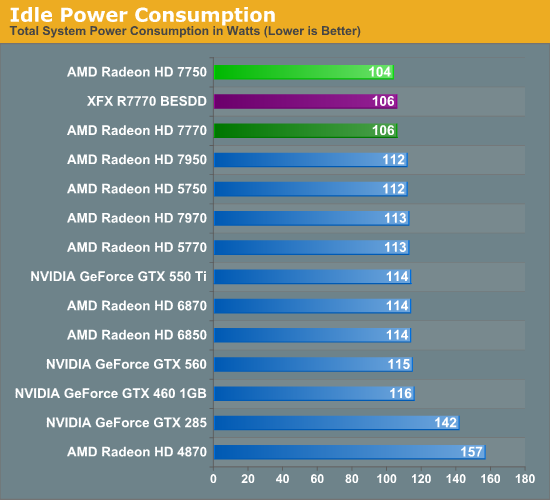
AMD’s official idle power consumption figure is <10W for both the 7750 and 7750. In practice we find that there’s a 2W difference between the two cards, with the 7750 coming in at 104W at the wall and the 7770 at 106W. AMD’s continuing efforts to reduce idle power consumption are clearly paying off, making this the lowest idle power usage figures we’ve recorded yet.
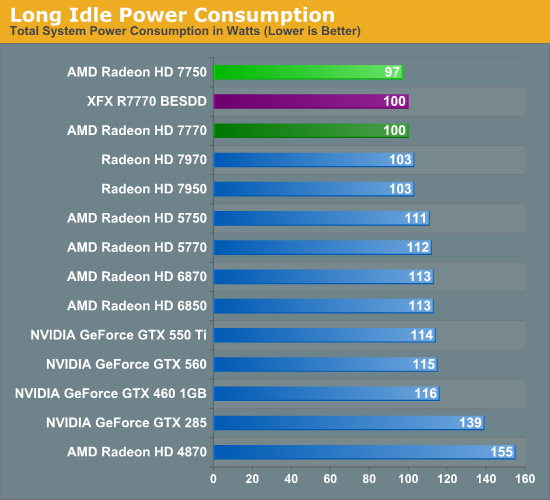
Meanwhile under the so-called “long idle” scenario with a blank monitor, the 7000 series continues to cement its lead. Officially all Southern Islands cards have a long idle power consumption level of <3W since they should all be using the same PCIe controller to keep a heartbeat going, however we’re finding there is a difference, even between the 7750 and 7770. The 7770 consumes 3W less than the 7900 series, meanwhile the 7750W consumes another 3W less, bringing it down to 97W. Since our readings are from the wall it’s tough to gage just how much these cards are still using, but at this point there doesn’t seem to be much farther to drop.
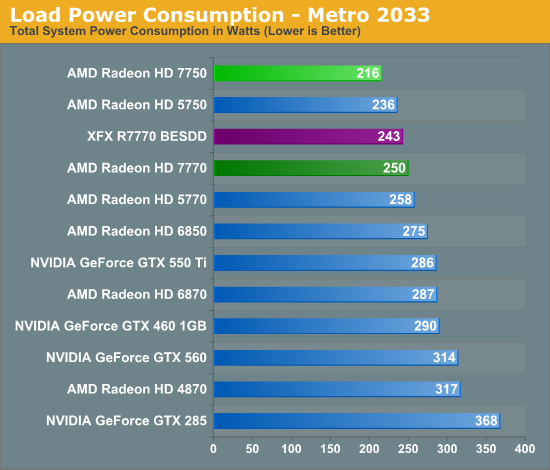
When we talk about the 7700 series bluring the line between what we’d expect out of an AMD 700 series card and an AMD 600 series card, results like this are part of the reason why. With a 75W PowerTune limit the 7750 has the lowest power consumption of any of the cards in our lineup, beating even the 5750. The 7750 is clearly in a league of its own, with only the 7770 drawing similar amounts of power as the 5700 series.
To that extent, it’s interesting to note that the XFX BESDD consumes less power than the reference 7770, in spite of its factory overclock. XFX did not increase the voltage of the card, but we’d still expect power consumption to go up at least a bit, not come down. In any case even with its 10% better performance, it’s consuming 7W less than the reference 7770 here. Otherwise at 250W the 7770 is pulling 8W less than the 5770 and 25W less than the 6850 from the wall, succinctly showcasing the power benefits of TSMC’s 28nm process.
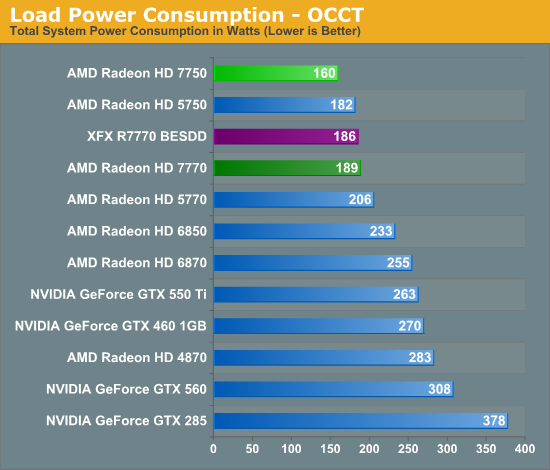
Our results with OCCT largely mirror Metro, with the 7750 in a class of its own while the 7770 consumes less power than anything other than the 5750. Since this is our pathological test, the lack of PowerTune plays a big part here, as PowerTune keeps the 7770 capped at 100W while the 5770 and 6850 are free to go well over their TDPs.
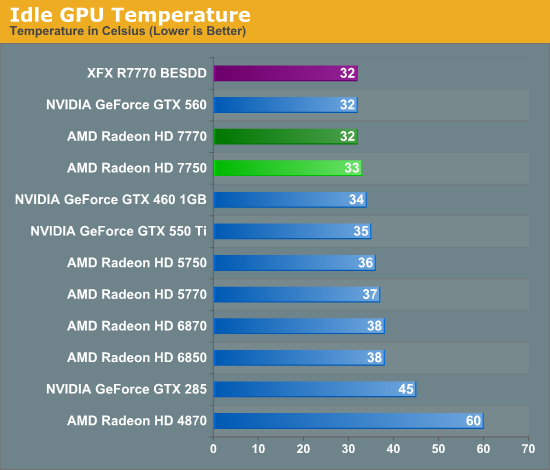
There’s little to say about idle temperatures that hasn’t been said before. With a half-decent cooler, almost any card can reach the mid-to-low 30s. The 7700 series is no exception.
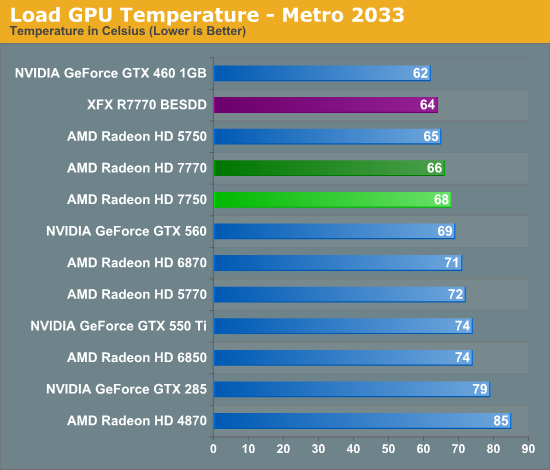
Moving on to Metro, our results are largely consistent with what we’d expect given our earlier power data. Even with the lower power consumption of the 7700 series AMD can’t quite beat the GTX 460 1GB, otherwise with temperatures in the mid to upper 60s the 7700 series looks quite good. XFX’s BESDD looks especially good thanks to the fact that it’s an open air cooler, as it only reaches 64C.

As with OCCT power consumption, OCCT temperatures are largely a story of PowerTune or the lack thereof. With PowerTune clamping down on power consumption, temperatures never rise by too much. At 71C the reference 7770 is still doing well, while XFX’s card does even better.
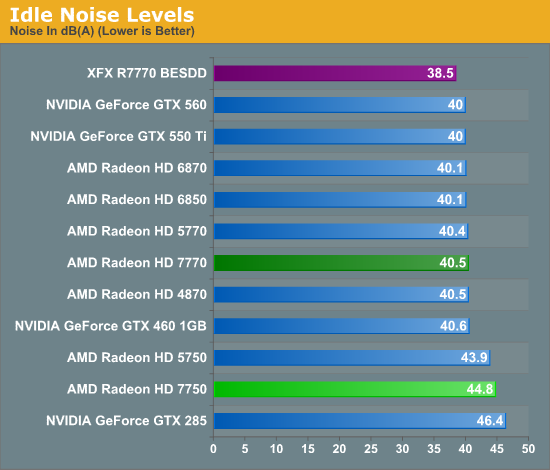
Based on our power and temperature data, our noise data came at somewhat of a disappointment. The 7750 has a small fan with an idle fanspeed of 39%, leading to it being quite loud relative to its competitors. Thankfully none of AMD’s partners will be using that specific cooler, so we wouldn’t expect any retail cards to be this bad. Though if silence is key, Sapphire’s passively cooled 7750 is always an option.
As for our 7770 cards there aren’t any surprises. The open air cooled XFX BESDD does the best, though at only 40.5dB the reference 7770 is doing almost as well on its own.
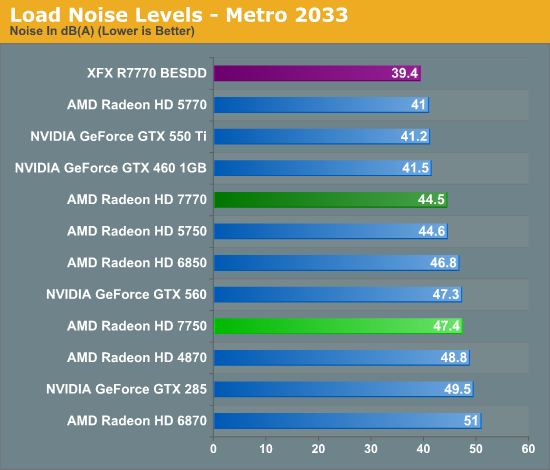
I had to rerun Metro a few times just to make sure our XFX BESDD numbers are right; and they were. XFX’s open air cooler combined with the 100W board limit of the 7770 means that there’s relatively little heat to dissipate, which the open air cooler does extremely well. While this isn’t technically silent it’s damn close.
Elsewhere the reference 7770 does decently, but its half blower nature hurts it when it comes to noise. The noisy 7750 only gets louder, unfortunately.
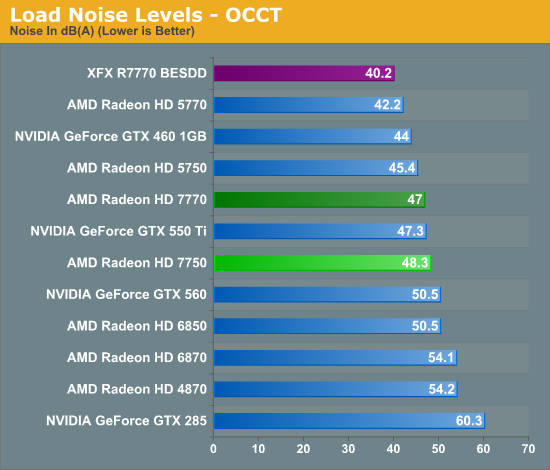
Finally, noise under OCCT is nearly the same story. The XFX BESDD finally goes above 40dB, a testament to the capabilities of XFX’s open air cooler. As for the AMD cards, there’s really not a great deal positive to say as even a traditional blower shouldn’t be quite as bad as what we’re seeing with the reference 7770. Perhaps it’s for the best that none of AMD’s partners are using their reference designs.










155 Comments
View All Comments
tipoo - Wednesday, February 15, 2012 - link
I probably won't be enticed into a video card upgrade until the next generation of Microsoft and Sony consoles are out. In the land of console ports, even a 6770 can run nearly everything comfortably at most common monitor resolutions.Movieman420 - Wednesday, February 15, 2012 - link
I have an OCd C2D Wolfdale running the 4850 and I also agree that the 4850 will go down as one of the best bang for the buck cards ever.My current i5/Z68 rig is running what I think will be considered another BBFTB card...the 6850...the dual fan Gigabyte 685OC in my case.
The 5770/6770/7770 are a fantastic line of mid-range cards...esp OCd but for a few $$ more an OCd 6850 still holds it's own quite well, there's no real counter for a 256bit vs 128bit memory bus. A big hats off tho to the 7770's high res numbers...pretty damn sweet, but I don't need uber res for a 23.5 inch monitor...ofc I'm not a hard core gamer either.
cjs150 - Wednesday, February 15, 2012 - link
7750 seems perfect for an HTPC. But to put it into context, IGPs should be using the 7750 as the benchmark for what to aim for. Can see this becoming completely obselete very soon once products based on Raspberry pi or Cu Box get released and match (the very impressive) picture quality of the 7750. In mean time get a low profile passive cooled version out and it will be perfect.As for the 7770 I simply see no purpose for it at all. NVidia 560 is only marginally more expensive and beats it completely. 7770 seems to me to be a complete waste of stock
Shadowmaster625 - Wednesday, February 15, 2012 - link
So the 7770 should be at $109, and that forces the 7750 down to $89 or less. The die sizes on these chips are a lot smaller than their competition so I dont see what AMD is thinking. Inflation? lol.Shadowmaster625 - Wednesday, February 15, 2012 - link
Why would a 7750 consumer 3 watts less than a 7770 during the "long idle" state. That really makes no sense. During that state there shouldnt be any difference at all between the two cards.tipoo - Wednesday, February 15, 2012 - link
It has over 100 more stream processors? 3W is pretty minuscule.akbo - Wednesday, February 15, 2012 - link
They are using a gorram 1200W PSU and those have s*** efficiency at 10% load. 3 watts means that it may pull about 1 watt more on-chip.KompuKare - Wednesday, February 15, 2012 - link
Which begs a simple question that has been bothering me with Anandtech GPU reviews for a while: how come they don't measure the wattage for the cards rather the whole system. Ok, it needs a custom PCI-E riser board and a multimeter but other sites (like techpowerup.com or this French site (can't think of it ATM) where the place I first saw that method used) manage it.Or at a minimum why is there no IGPU (Intel 3000) power usage in the review to act as a baseline?
Death666Angel - Wednesday, February 15, 2012 - link
I'm kinda disappointed by the 77xx launch. I'd have hoped for some €150 - €200 cards, consequently performing better than the 6870. Maybe the 78xx will be better. I really hope nVidia comes around with good cards, that way the consumer won't get ripped off. Although I also hope that AMD makes some money in the mean time.geniekid - Wednesday, February 15, 2012 - link
I just want to reiterate how much I appreciate the games you've chosen for your benchmarks. It's a very diverse set of games and covers a lot of the non-FPS genres that other review sites tend to leave out.